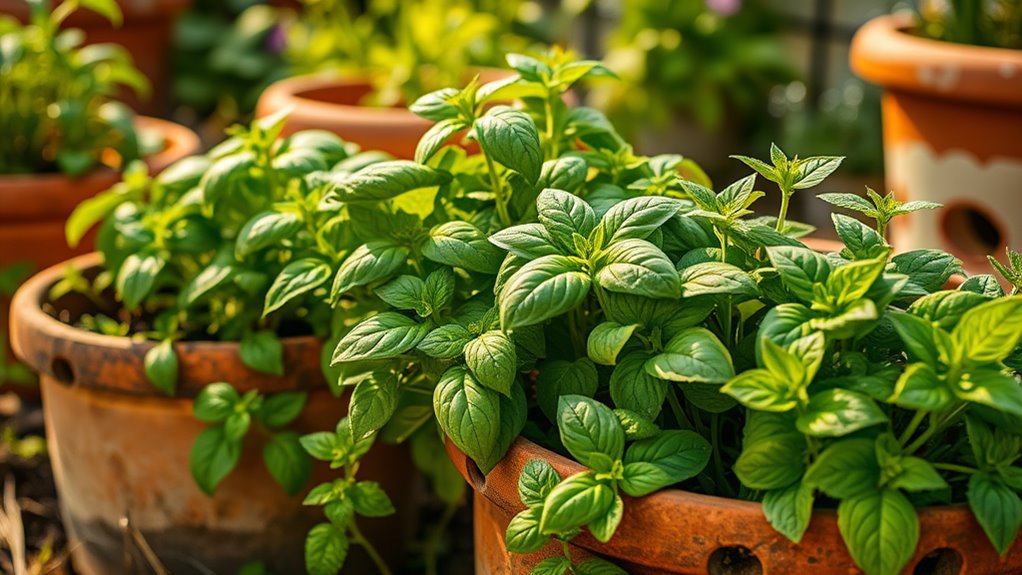I Planted These Herbs Once and They Keep Coming Back!
You’ve planted perennial herbs like rosemary, thyme, sage, or mint once, and they’re reliably returning each year due to their hardy nature, thriving in poor soil and various weather with minimal effort. This resilience saves you time and money, while providing fresh flavors for your meals and boosting garden biodiversity through pollinators. Keep them healthy by checking soil moisture weekly and mulching to prevent issues. Explore top picks and care tips to maximize your thriving herb garden.
Top Perennial Herbs to Try
If you’re looking to build a low-maintenance herb garden, start with these top perennial herbs that return year after year with minimal effort.
You’ll thrive with rosemary, which handles poor soil easily; thyme, spreading in sunny spots; sage, offering aromatic leaves; and oregano, growing vigorously. Additionally, many of these herbs are known for their hardy resilience and can endure various weather conditions.
Choose hardy varieties suited to your region, plant in well-drained areas, and let them establish roots for enduring gardens.
Advantages of These Hardy Plants
These hardy plants bring clear benefits to your garden, starting with their resilience that saves you time and effort each season.
They’re cost-effective, as you won’t need to buy new plants annually, freeing up your budget for other pursuits.
Plus, they enrich soil naturally, boost biodiversity by attracting pollinators, and deliver a reliable harvest of fresh flavors, enhancing your meals effortlessly. Additionally, many of these herbs are suitable for small spaces, making them perfect for urban gardening enthusiasts.
Simple Ways to Get Started
How can you kick off growing these resilient herbs without overwhelming yourself? Start by selecting hardy options like mint, thyme, oregano, rosemary, or sage, then prepare well-drained soil in a sunny spot. It’s also important to keep in mind soil selection to ensure your herbs thrive.
| Herb | Key Step | Essential Tool |
|---|---|---|
| Mint | Loosen soil | Garden fork |
| Thyme | Add organic matter | Small trowel |
| Oregano | Provide good drainage | Watering can |
| Rosemary | Plant in full sun | Pruning shears |
| Sage | Mulch base lightly | Gardening gloves |
Tips for Ongoing Care
Once you’ve established your herbs, regularly monitor them to keep them thriving in your garden.
Check soil moisture weekly and adjust watering to prevent root rot or drought stress.
Prune dead growth to encourage new shoots, and inspect for pests early.
- Water deeply but infrequently to promote deep roots.
- Mulch around plants to retain moisture and suppress weeds.
- Fertilize sparingly with organic compost every few months.
- Divide overcrowded clumps every 2-3 years for health.
In addition, growing herbs indoors can enhance the flavor of your meals while providing a decorative touch to your kitchen.
Creative Uses in the Kitchen
Beyond their garden resilience, you’ll find that perennial herbs like mint, rosemary, and thyme offer versatile ways to enhance your kitchen creations, adding fresh flavors and nutritional boosts to everyday meals.
In the kitchen, you’ll love using mint to flavor desserts, rosemary for infusing oils, and thyme in pasta sauces.
These herbs let you create gourmet meals at home, boosting flavor profiles while providing antioxidants and vitamins that support your well-being. Additionally, growing herbs indoors allows for year-round access to fresh ingredients, enhancing your culinary adventures regardless of the season.

